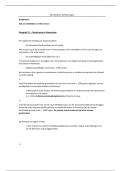College aantekeningen
Emotions: Scientific & Clinical Aspects - Lecture notes
Elaborate notes of all the lectures of the course: Emotions: Scientific & Clinical Aspects. An overview of the subjects: Lecture 1: Crying, Lecture 2: Mindfulness, Lecture 3: Emotions, Lecture 4: Evolution, Lecture 5: Emotion appraisal, Lecture 6: Matter of emotion, Lecture 7: Commu...
[Meer zien]









